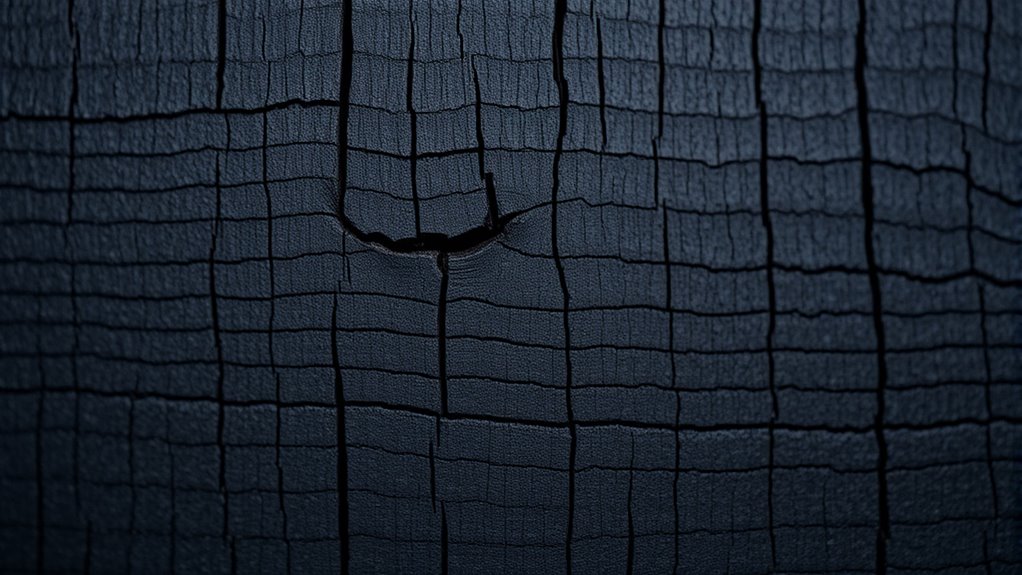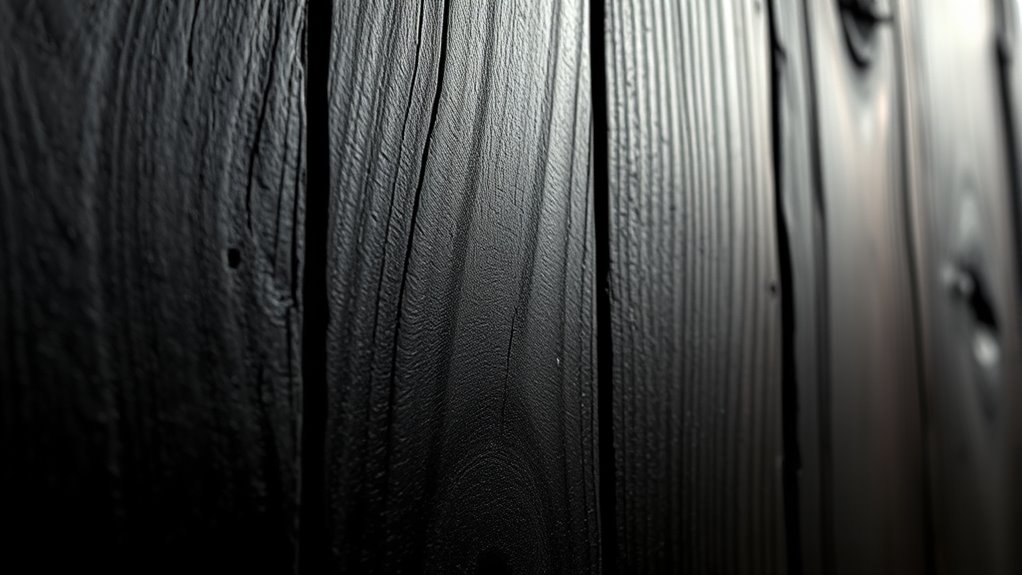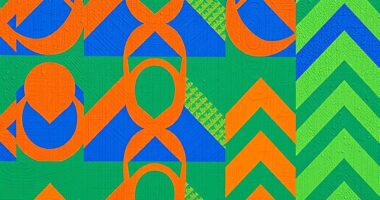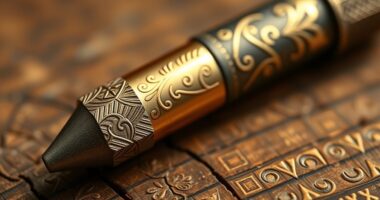Shou Sugi Ban is a traditional Japanese technique where you burn wood surfaces, usually cedar or cypress, to create durable, visually striking finishes. By carefully charring the wood with controlled flames, you can achieve a range of textures and colors, from deep black to subtle gray tones. This method naturally enhances resistance to pests, mold, and rot while providing a unique, rustic look. Keep exploring to uncover how this ancient craft can add character and longevity to your projects.
Key Takeaways
- Shou Sugi Ban is a traditional Japanese technique of charring wood surfaces for durability and aesthetic appeal.
- It primarily uses cedar or cypress wood, burned with controlled flames to create textured, darkened finishes.
- The process involves careful burning, brushing, and sealing to enhance resistance against pests, mold, and decay.
- Modern applications include interior design, furniture, and exterior cladding, blending tradition with contemporary aesthetics.
- This technique offers a natural, eco-friendly alternative to chemical treatments, emphasizing sustainability and timeless style.

Have you ever wondered how ancient Japanese craftsmen transformed wood into a durable, visually striking surface? The answer lies in a centuries-old technique called shou sugi ban, which involves charring wood with fire to create a unique, protective finish. This method is rooted in traditional craftsmanship, where artisans carefully burn the wood’s surface to achieve the desired texture and coloration. Originally developed in Japan as a practical solution for exterior siding and fencing, shou sugi ban has stood the test of time due to its durability and aesthetic appeal. Today, it’s experiencing a resurgence in modern applications, from interior design to furniture making, thanks to its natural look and eco-friendly qualities.
Ancient Japanese craft transforms wood with fire, creating durable, beautiful surfaces through the timeless shou sugi ban technique.
When you explore the process, you’ll see how the craftsmanship is both art and science. Artisans select specific types of wood, usually cedar or cypress, because they respond well to the burning process. The wood is then carefully scorched using controlled flames, which chars the surface without igniting the entire piece. The degree of burn can vary, producing a range of textures and colors—from deep black to dark brown, or even subtle gray tones. After burning, the surface is brushed to remove loose soot and sometimes sealed with oils or sealants to enhance longevity and appearance. This meticulous attention to detail exemplifies traditional craftsmanship, where every step is deliberate to guarantee a beautiful, durable result.
In its modern applications, shou sugi ban is appreciated not only for its striking visual contrast but also for its resilience. The charred surface naturally resists pests, mold, and rot, reducing the need for chemical treatments. This makes it an environmentally friendly choice for exterior cladding, siding, or even feature walls inside homes and commercial spaces. Architects and designers love how the technique can be customized—varying the burn depth and finishing techniques allows for a wide spectrum of styles, from sleek modern to rustic traditional. Its versatility means you can incorporate burnt wood into various design themes, blending history with contemporary aesthetics.
Ultimately, shou sugi ban bridges the gap between age-old tradition and modern innovation. Its roots in traditional craftsmanship give it authenticity, while its adaptability keeps it relevant today. Whether you’re considering it for a small interior accent or a large exterior façade, this technique offers a timeless, sustainable solution that adds character and durability to any project. Understanding its history and modern uses reveals just how powerful simple, natural processes can be when applied with skill and creativity.
Frequently Asked Questions
Is Shou Sugi Ban Suitable for Indoor Use?
Yes, you can use shou sugi ban indoors, but consider indoor durability and safety considerations. Burnt wood offers excellent durability and a unique aesthetic, making it suitable for interior walls or furniture. However, guarantee proper sealing to prevent soot residue and make cleaning easier. Also, verify that the finish is safe and free of harmful chemicals, so it’s both beautiful and safe for your indoor space.
How Long Does Shou Sugi Ban Last Outdoors?
You might think shou sugi ban lasts forever outdoors, but its durability depends on several factors. Research shows that properly treated and sealed burnt wood can resist weather for up to 25 years, thanks to its enhanced weather resistance. However, exposure to harsh elements, like heavy rain or intense sun, can shorten its lifespan. Regular maintenance extends its wood durability, ensuring your burnt wood continues to protect and beautify your exterior for decades.
Can Shou Sugi Ban Be Applied on Any Wood Type?
You can apply shou sugi ban on many wood types, but not all are ideal for application suitability. Softwoods like cedar and pine work well because they resist burning evenly and develop a beautiful char. Hardwoods, such as oak or maple, may be more challenging to burn uniformly and could require adjustments. Always consider the wood type’s grain and density to guarantee a successful application of the burnt finish.
What Are the Environmental Impacts of Shou Sugi Ban?
Imagine a smoky breeze carrying the scent of charred wood, revealing its environmental story. When you choose Shou Sugi Ban, you’re often supporting sustainable sourcing, reducing the need for chemical treatments, and lowering the carbon footprint. By preserving wood naturally, you minimize waste and toxic emissions. This eco-friendly technique not only beautifies your space but also helps protect the planet, turning burnt wood into a symbol of sustainable craftsmanship.
How Does Shou Sugi Ban Compare to Other Wood Finishes?
You’ll find that shou sugi ban offers a unique aesthetic appeal with its charred, textured look, making it stand out among wood finishes. It generally requires less maintenance because the burnt surface resists pests and decay. Compared to traditional finishes, it’s more durable and eco-friendly, reducing the need for chemical treatments. Overall, shou sugi ban combines striking visual appeal with lower upkeep, making it a smart choice for durable, beautiful wood surfaces.
Conclusion
Now that you’ve explored the art of Shou Sugi Ban, you might believe it’s just about aesthetics. But the truth is, its ancient fire-curing process also protects wood from pests and weather, making it incredibly durable. So, while it looks striking, you’re actually embracing a proven, eco-friendly method that enhances longevity. Next time you see burnt wood, remember—you’re witnessing centuries-old craftsmanship blending beauty with practicality.









